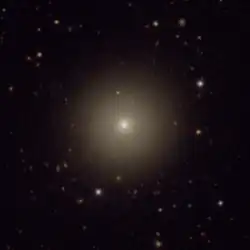| NGC 119 | |
|---|---|
 DECam image of NGC 119 | |
| Observation data (J2000 epoch) | |
| Constellation | Phoenix |
| Right ascension | 00h 26m 57.61014s[1] |
| Declination | −56° 58′ 41.0368″[1] |
| Redshift | 0.024634[2] |
| Heliocentric radial velocity | 7294 km/s[2] |
| Distance | 329.8 Mly (101.11 Mpc)[3] |
| Apparent magnitude (V) | 15.70[4] |
| Apparent magnitude (B) | 14.15[4] |
| Characteristics | |
| Type | SA0− pec[5] |
| Other designations | |
| PGC 1659[2] | |
NGC 119 is an unbarred lenticular galaxy with an apparent magnitude of 13.0 located in the constellation Phoenix. It was discovered on October 28, 1834 by the astronomer John Herschel.[6]
See also
References
- 1 2 Brown, A. G. A.; et al. (Gaia collaboration) (August 2018). "Gaia Data Release 2: Summary of the contents and survey properties". Astronomy & Astrophysics. 616. A1. arXiv:1804.09365. Bibcode:2018A&A...616A...1G. doi:10.1051/0004-6361/201833051. Gaia DR2 record for this source at VizieR.
- 1 2 3 "NGC 119". SIMBAD. Centre de données astronomiques de Strasbourg. Retrieved 2021-02-21.
- ↑ Crook, Aidan C.; Huchra, John P.; Martimbeau, Nathalie; Masters, Karen L.; Jarrett, Tom; Macri, Lucas M. (2007). "Groups of Galaxies in the Two Micron All Sky Redshift Survey". The Astrophysical Journal. 655 (2): 790–813. arXiv:astro-ph/0610732. Bibcode:2007ApJ...655..790C. doi:10.1086/510201. S2CID 11672751.
- 1 2 "Search specification: NGC 119". HyperLeda. Université Claude Bernard Lyon 1. Retrieved 2021-02-21.
- ↑ "Results for object NGC 0119 (NGC 119)". NASA/IPAC Extragalactic Database. California Institute of Technology. Retrieved 2021-02-21.
- ↑ "New General Catalog Objects: NGC 100 - 149". cseligman.com. Retrieved 2015-10-13.
This article is issued from Wikipedia. The text is licensed under Creative Commons - Attribution - Sharealike. Additional terms may apply for the media files.